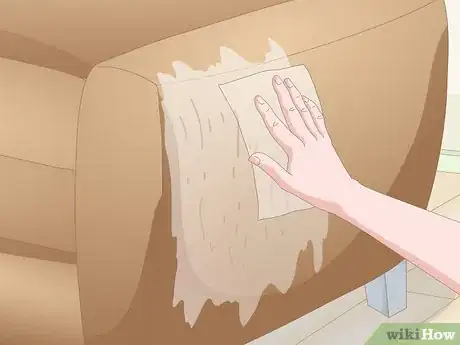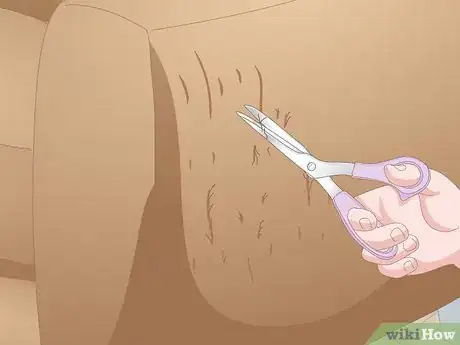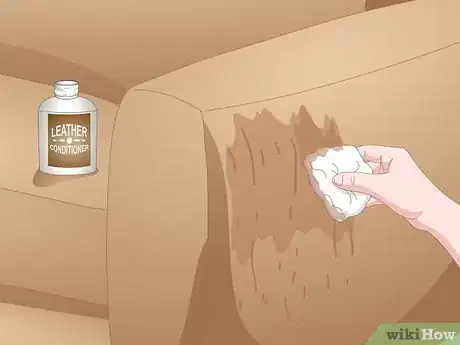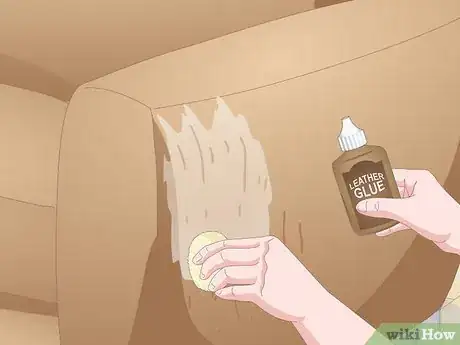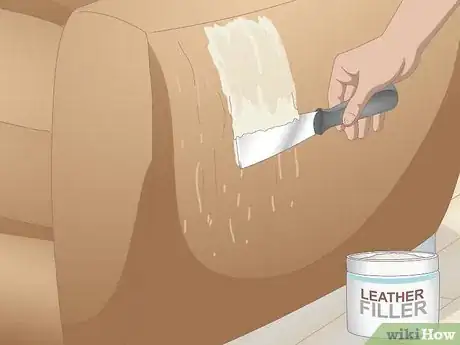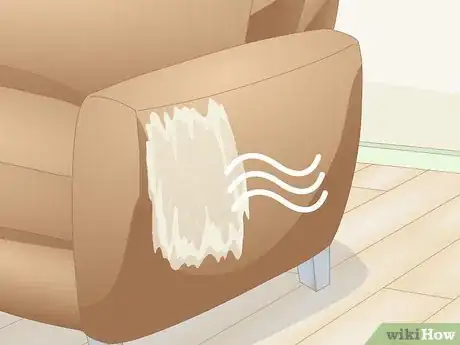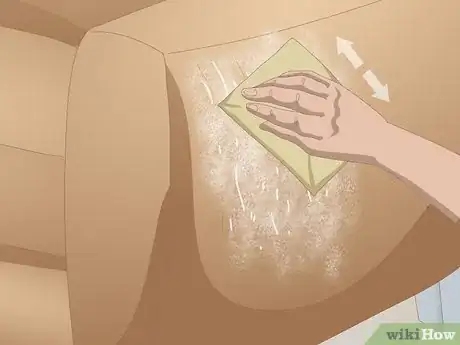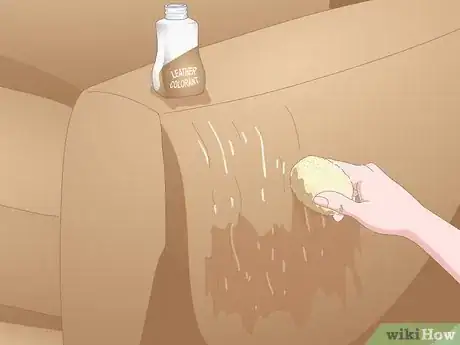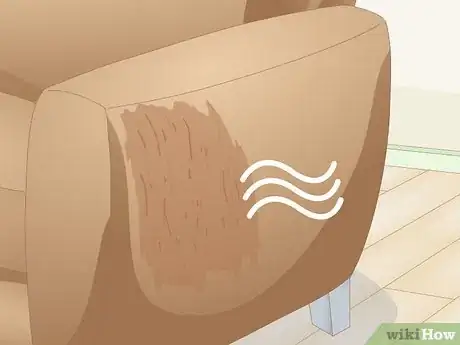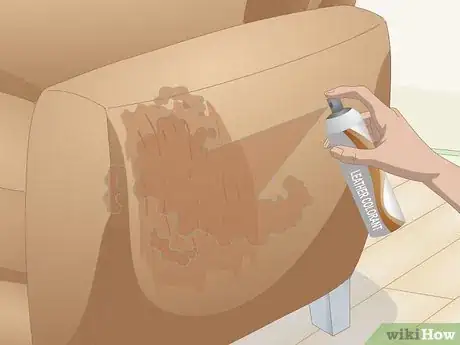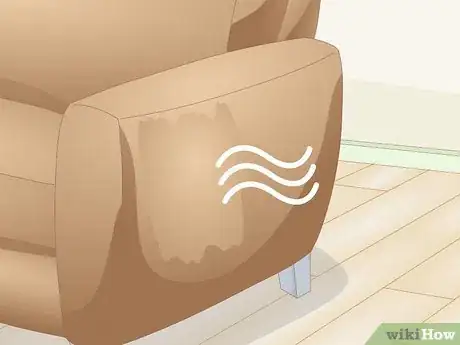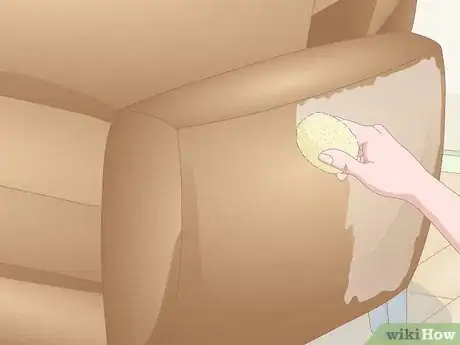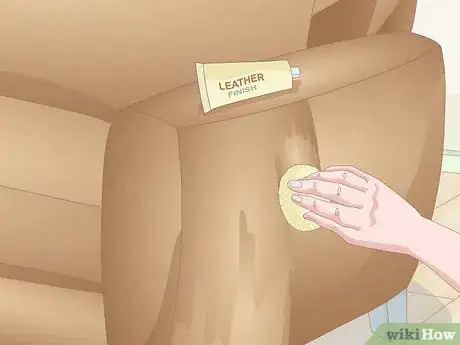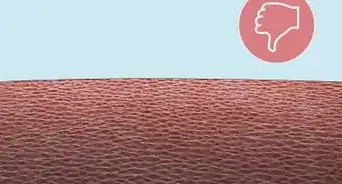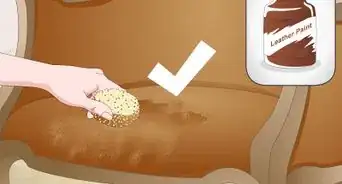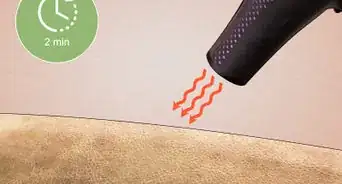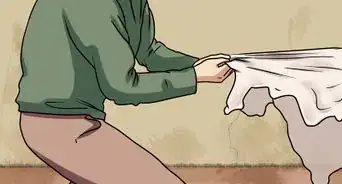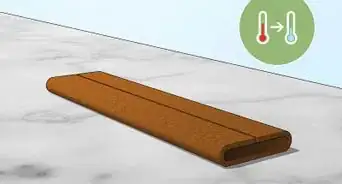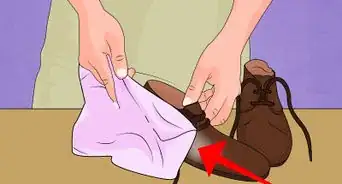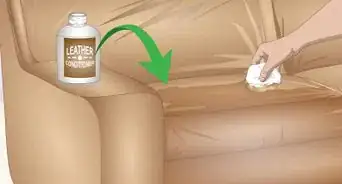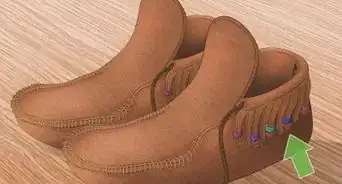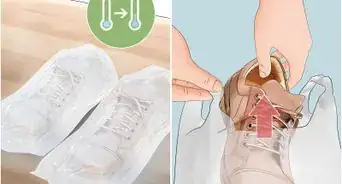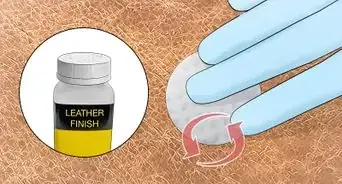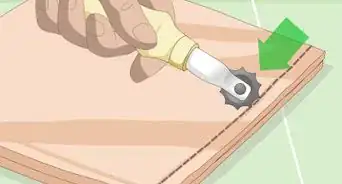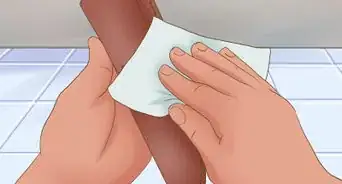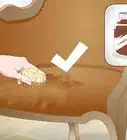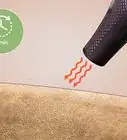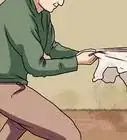This article was co-authored by Mallika Sharma and by wikiHow staff writer, Janice Tieperman. Mallika Sharma is a Certified Leather Care Technician and the Founder of The Leather Laundry, a niche spa service for luxury leather gear in India. Mallika specializes in leather cleaning, coloring, repairing, and restoring for shoes, handbags, jackets, wallets, belts, and sofas. She holds a Master’s degree in Finance and Investment from the University of Edinburgh Business School. Mallika is a certified Professional Leather Care Technician and trained with the globally reputed leather care company, LTT in the United Kingdom.
There are 9 references cited in this article, which can be found at the bottom of the page.
This article has been viewed 73,165 times.
There’s nothing more annoying than your cat deciding to use your leather furniture as a scratching post. While cat scratches are an eyesore, they don’t have to be a permanent decoration of your leather goods. With specific leather supplies, you can make your leather look completely unscathed.
Steps
Conditioning and Sanding the Scratched Area
-
1Clean off the surface with a leather wipe. The leather needs to be as clean as possible before you repair it. Clear off any lingering dust or dirt with a leather cleaning wipe. Use small, circular motions to clean the leather surface thoroughly.[1]
- If you don’t have any leather wipes on hand, you can buy some at a home improvement store or online.
-
2Remove any stray fibers with scissors or a lighter. Use a pair of scissors to snip off any loose strands from the leather.[2] You can also use a lighter on the scratched area, as the heat of the flame will loosen the punctured and scratched leather.[3]Advertisement
-
3Moisten the area with leather conditioner. Start by dampening the scratched leather surface with a small amount of leather conditioner. You can find leather conditioner at some drug stores or online.[4]
- The conditioner prepares the leather for the glue and filler that will go on top of
- If you are working with aniline leather, be sure to use distilled water.
-
4Apply thin layers of leather glue to the affected area. Pour a coin-sized amount of glue to the sponge. Then, use a sponge to spread a thin layer of glue onto the leather. For the best results, apply at least 7 layers of glue to the scratched leather.[5]
- Let each layer of glue dry before you apply another one.
- Leather glue reconnects the punctured portions of the leather.[6]
-
5Sand down the leather after the glue has dried. Using soft sandpaper (around 1200 grit), sand down the glue with smooth and circular strokes. Make the surface as smooth as possible so that the leather filler won’t look lumpy when you apply it.[7]
- Make sure to wipe down any leftover dust from the sandpaper before continuing.
Repairing the Leather
-
1Use a palette knife to apply leather filler. Dip a plastic palette knife into the leather filler and paint a thin layer onto the glued leather. Make this layer as smooth as possible, so that the leather doesn’t look messy. Feel free to add another layer of filler if you think your leather needs it.[8]
- Make sure the first layer of filler has dried for at least 20 minutes before adding any more.
- Purchase a palette knife at a home improvement store if you don’t have one on hand. You can use a spatula instead of a palette knife.[9]
- For a more precise application, apply the filler cream to a needle. Apply the filler gently to the surface, then use the side of the needle to even out or buff the cream with the needle.[10]
-
2Wait for the filler to dry. Let the leather air dry in your work area before proceeding. Depending on the type of filler you’re using, you may have to wait at least several hours before it is totally dry.[11]
- If you’re working in a room or area with a lot of humidity, it may take longer for the leather filler to dry.[12]
-
3Smooth the filler with sandpaper. Use another piece of gentle (1200 grit) sandpaper to smooth and buff out any inconsistencies on the filler’s surface. This helps to keep the surface of your leather as smooth as possible, so the finished repair looks natural and authentic.[13]
-
4Wipe any excess dirt and dust from the filled area. Before you start to recolor anything, use a moist wipe or a liquid cleaning product specific to leather to clean and polish off the surface. There may be some sandpaper grit leftover on the surface of the filler. [14]
- Leather cleaner can be found at generic stores that sell cleaning supplies or at home improvement stores.
- If you don’t have any leather cleaner on hand, a baby wipe can work in a pinch.[15]
Recoloring the Surface
-
1
-
2Let the colorant dry completely. Before you continue on with any more layers of colorant and sealant, make sure that the first layer of colorant has dried completely.[18]
- To speed up the drying process, use a hair dryer at a low heat setting.
-
3Spray on additional colorant to the treated area. Use a spray colorant to apply another layer of color to enhance the initial layer of colorant. [19] If your leather is multiple colors, use different shades of colorant to reach your desired shade.[20] Apply at least 4-5 thin layers of spray-on colorant to get a full, vibrant color on your treated leather area.[21]
- Make sure each layer is dry before you add another.[22]
-
4Allow the leather to fully dry. To avoid the colorant from smearing along the leather’s surface, make sure that it has dried completely. Thankfully, thin layers don’t take as long to dry. This could take around half an hour or more.
- Check the directions on your colorant bottle to find a specific estimate on how long it will take to dry.
-
5Rub a sealant into the leather with a sponge. Use a new sponge to paint at least 3 layers of sealant onto the leather. Make sure that each layer is dry before you add more sealant. The sealant will keep the leather colorant vibrant and protected.[23]
- Double check your sealant’s packaging to get a rough estimate on the drying time.
-
6Apply a leather finishing product after the sealant dries. Place a coin-sized amount of leather finishing product on the sponge before rubbing it on top of the leather. Use short, circular motions to get an even finish. Try to have at least 4 thin coats of finish to get an adequate protection layer.[24]
- The leather finishing product provides another layer of protection.
- Ensure that each layer of finish has dried before you add another one.
Expert Q&A
Did you know you can get expert answers for this article?
Unlock expert answers by supporting wikiHow
-
QuestionHow do I get cat scratches out of leather?
 Mallika SharmaMallika Sharma is a Certified Leather Care Technician and the Founder of The Leather Laundry, a niche spa service for luxury leather gear in India. Mallika specializes in leather cleaning, coloring, repairing, and restoring for shoes, handbags, jackets, wallets, belts, and sofas. She holds a Master’s degree in Finance and Investment from the University of Edinburgh Business School. Mallika is a certified Professional Leather Care Technician and trained with the globally reputed leather care company, LTT in the United Kingdom.
Mallika SharmaMallika Sharma is a Certified Leather Care Technician and the Founder of The Leather Laundry, a niche spa service for luxury leather gear in India. Mallika specializes in leather cleaning, coloring, repairing, and restoring for shoes, handbags, jackets, wallets, belts, and sofas. She holds a Master’s degree in Finance and Investment from the University of Edinburgh Business School. Mallika is a certified Professional Leather Care Technician and trained with the globally reputed leather care company, LTT in the United Kingdom.
Certified Leather Care Technician
Things You’ll Need
- Leather wipes
- Scissors
- Lighter
- Distilled water (optional)
- Leather conditioner
- Leather glue
- Fine grit sandpaper
- Palette knife
- Spatula (optional)
- Leather filler
- Leather cleaner
- Wet wipes (optional)
- Leather colorant
- Spray-on colorant
- Leather sealant
- Leather finishing product
- Sponges
References
- ↑ https://petcentral.chewy.com/pet-parenting-diy-recipes-how-to-fix-cat-scratches-on-leather/
- ↑ https://petcentral.chewy.com/pet-parenting-diy-recipes-how-to-fix-cat-scratches-on-leather/
- ↑ https://m.youtube.com/watch?v=Q5LGz_vw6HM&t=0m14s
- ↑ https://m.youtube.com/watch?v=Q5LGz_vw6HM&t=0m24s
- ↑ https://petcentral.chewy.com/pet-parenting-diy-recipes-how-to-fix-cat-scratches-on-leather/
- ↑ https://www.mohawk-finishing.com/mhk_cds/color_chart/Leather%20Product%20Guide.pdf
- ↑ https://petcentral.chewy.com/pet-parenting-diy-recipes-how-to-fix-cat-scratches-on-leather/
- ↑ https://petcentral.chewy.com/pet-parenting-diy-recipes-how-to-fix-cat-scratches-on-leather/
- ↑ https://www.mohawk-finishing.com/mhk_cds/color_chart/Leather%20Product%20Guide.pdf
- ↑ Mallika Sharma. Certified Leather Care Technician. Expert Interview. 14 December 2020.
- ↑ https://www.mohawk-finishing.com/mhk_cds/color_chart/Leather%20Product%20Guide.pdf
- ↑ https://www.bobvila.com/articles/how-long-does-it-take-paint-to-dry/
- ↑ https://petcentral.chewy.com/pet-parenting-diy-recipes-how-to-fix-cat-scratches-on-leather/
- ↑ https://petcentral.chewy.com/pet-parenting-diy-recipes-how-to-fix-cat-scratches-on-leather/
- ↑ https://experthometips.com/39-unexpected-uses-for-baby-wipes-adults
- ↑ Mallika Sharma. Certified Leather Care Technician. Expert Interview. 14 December 2020.
- ↑ https://petcentral.chewy.com/pet-parenting-diy-recipes-how-to-fix-cat-scratches-on-leather/
- ↑ https://petcentral.chewy.com/pet-parenting-diy-recipes-how-to-fix-cat-scratches-on-leather/
- ↑ https://petcentral.chewy.com/pet-parenting-diy-recipes-how-to-fix-cat-scratches-on-leather/
- ↑ https://m.youtube.com/watch?v=Q5LGz_vw6HM&t=1m24s
- ↑ https://petcentral.chewy.com/pet-parenting-diy-recipes-how-to-fix-cat-scratches-on-leather/
- ↑ https://petcentral.chewy.com/pet-parenting-diy-recipes-how-to-fix-cat-scratches-on-leather/
- ↑ https://petcentral.chewy.com/pet-parenting-diy-recipes-how-to-fix-cat-scratches-on-leather/
- ↑ https://petcentral.chewy.com/pet-parenting-diy-recipes-how-to-fix-cat-scratches-on-leather/
- ↑ https://petlifetoday.com/best-cat-pheromone-sprays/
